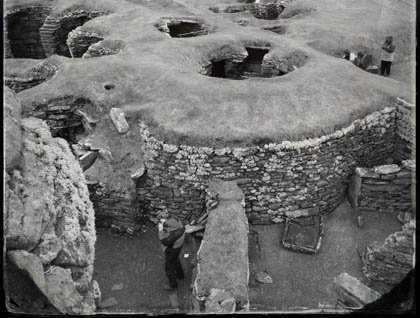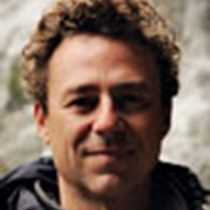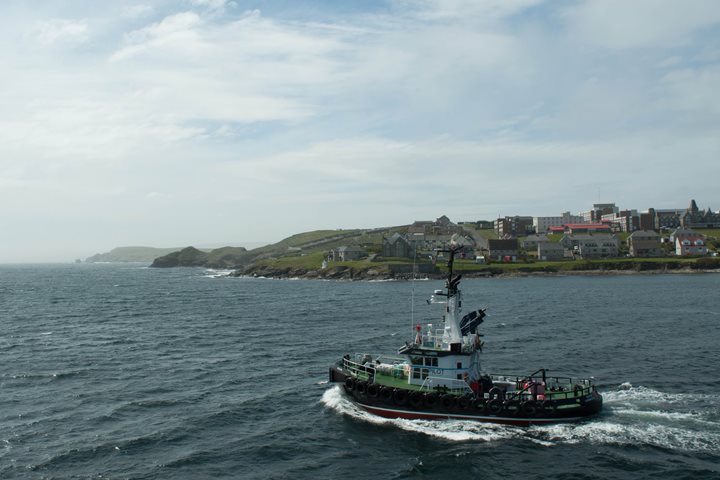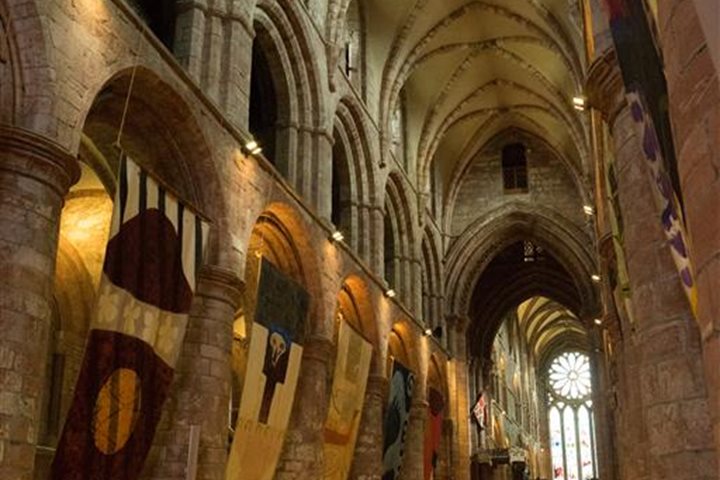On our last full day of this British and Irish Isles expedition we were treated to a sample of the windswept and rainy conditions that locals endure on a regular basis. We emerged from the ship at 7:45 in the morning and rushed to the awaiting buses. National Geographic Explorer was docked a stone's throw from downtown Lerwick, the picturesque city that was founded in the 17th century, relatively recently for this island whose record of human habitation stretches back thousands of years. We peered through rain-covered windows at the grey stone houses that make up the city center, winding our way through the city streets on our way to the Shetland countryside. As we left the city, we saw the ruins of the ancient Clickimin Broch, a stone structure that served either as an ancient dwelling, a defensive structure, a status symbol, or perhaps all three.
The Shetland landscape is dotted with landmarks of ancient history. Shetland was actually part of Norway until 1469, when it was given by the King of Norway, Christian I, to James III of Scotland as part of the dowry for the wedding between James and Christian I's daughter, Margaret. Shetland was included as part of the dowry when Christian I could not come up with the cash he had previously committed to, under the condition that Norway could buy Shetland back for the same value at any time. Some people in Shetland still hope that will happen…there's a great deal of cultural legacy from the era of the Vikings and Norwegian rule and many Shetland islanders feel a closer connection to Scandinavia then Britain. Many place names derive from Norse roots, and the haunting strains of Nordic fiddle music that can be heard in the local music styles are haunting evidence of this history.
There is more tangible evidence of the past as well, as exemplified by our visit to Jarlshof, a fascinating, multi-layered archeological site. On this small hill near the sea, can be found the ruins of a 16th century manor house that once belonged to the illegitimate brother of Mary Queen of Scots. Long after it had been abandoned in the 1700s, the dunes beneath the manor were eroded by the regular storms, and in the late 1880s mysterious stone structures were revealed. It soon became apparent that the earth beneath this manor contained buildings that dated back over 4,000 years. The unique feature of Jarslhof is the way in which successive layers reveal different eras of history. The further down you dig, the deeper back in time you go, from the 16th century manor to a 9th century Viking farmstead, to iron age wheelhouses and ultimately bronze age structures that date back to 2,500 B.C. It's an awe-inspiring site, although the fierce winds and sideways rain that pelted us as we walked through the site did not allow for much lingering. We crowded around our guide, huddled in our raingear like multi-colored penguins sheltering from Arctic winds, to hear about all that we have learned from Jarlshof as well as the mysteries and questions it raises.
From there we headed to the lighthouse at Sumberg Head, perched atop a dramatic peak that is also home to an impressive array of birdlife. The hardy few of us who managed the climb to the top of the hill were treated to close up encounters with puffins, an adorably cute bird whose awkward, comical flying techniques only make them more endearing. Indeed, this day offered a number of supremely cute animals, from the newborn lambs hopping jovially on the hillsides to the Shetland pony foals just discovering the possibilities of their spindle-thin legs. We also managed to spy a number of harbor seals, their heads poking curiously out of the water. As our trip comes to a close, I am reminded of the Scottish tradition of singing "Auld Lang Syne" at the end of important social gatherings. We experienced this just the night before at the end of our traditional Shetland dance gathering in a nearby community center. Our new local friends had invited us into their world for a night of dancing, celebration, and community, and to end the evening we all stood in a circle, joined hands and sang the iconic song about friendship and nostalgia. In Scotland, the song begins slowly, but ends on a high note with the speed of the song picking up and everyone running into the center of the circle followed by three cheers. I found it to be a thoroughly joyful and powerful experience.
While "Auld Lang Syne" is generally attributed to the Scottish poet Robert Burns, he actually based his words on a much older song and his new words were applied to a previously existent melody. Originally sung during Hogmanay, Scottish New Year's Eve, it spread around the British Isles and on to the rest of the world through immigrants who brought the song and tradition with them. It is now one of the world's most recognized songs, and the melody has even been used as the basis of the national anthems of the Maldives and Korea. "Auld Lang Syne" means literally "old long since" but means roughly "for old times sake." So, in honor of the end of another wonderful voyage, please (virtually) join us in singing "Auld Lang Syne." Until the next time!
Should auld acquaintance be forgot
And never brought to mind?
Should auld acquaintance be forgot
And auld lang syne?
CHORUS
For auld lang syne, my jo
For auld lang syne
We’ll tak' a cup o’ kindness yet
For auld lang syne
And surely ye’ll be your pint-stoup!
And surely I’ll be mine!
And we’ll tak' a cup o’ kindness yet,
For auld lang syne
CHORUS
We twa hae run about the braes
And pou’d the gowans fine
But we’ve wander’d mony a weary fit
Sin' auld lang syne
CHORUS
We twa hae paidl’d in the burn
Frae morning sun till dine;
But seas between us braid hae roar’d
Sin' auld lang syne
CHORUS
And there’s a hand, my trusty fiere!
And gie's a hand o’ thine!
And we’ll tak' a right gude-willie waught,
For auld lang syne
CHORUS







